SUBFAMILY MYRMICINAE - Genus Pheidologeton
| The Ants of
Africa SUBFAMILY MYRMICINAE - Genus Pheidologeton |
|
| Contents - Myrmicinae - MYRMICINAE Introduction |
In Tribe PHEIDOLOGETONINI.
Diagnostic Features - Strongly polymorphic, usually with a
graded series connecting the minor workers with the large majors .
Mandibles of major workers edentate or with reduced rounded teeth,
minor workers with five or six teeth. Eyes present. Antennae
11-segmented with a 2-segmented club. Promesonotal suture absent in
minor workers, increasingly developed with increased worker size.
Metanotal groove impressed; propodeum bispinose. Red or red-brown to
black, head and thorax sculpture variable, usually less pronounced in
minors, gaster smooth and shiny. Mayr's (1862: 750) description of the
genus is at ![]() .
.
See the illustration as an example of the highly divergent polymorphism - Pheidologeton kunensis Ettershank (1966); originally described by Santschi (1928f) as Ph. arnoldi.
Bolton (1973a) notes the members are found under rotten logs and are uncommon in West Africa but it will be seen that there are no reports of workers from West Africa or the Congo Basin and that there is no association between the species below as regards males and queens - the simple answer may be that there is only one species represented in the area. Bolton's note appears to have been taken from Ettershank (1966), who examined the genus group and wrongly cited the Santschi (1937d) record of aberrans as "West Africa". There is no modern taxonomic revision.
All the African species for which asexual stages are known, plus diversus standfussi", appear to be the same colour, generally medium brown, with the pedicel, gaster and anterior head dark brown, and much lighter than the dark type form of diversus. It may be that there is a single sole African species, if so the prior name is Pheidologeton hostilis (F Smith).
Species
described from Africa
| West African species |
||
| Queen only described | Queen TL 20 mm; head wider than
long; general colour dark brown - no images |
Togo - solitarius |
| Male only described | Male TL 7.5 mm; yellow, some
parts brownish; wings grey with nerves yellow or brownish, forewing
length 7.5 mm Photomontage on species page |
Cameroun - volsellata |
| Southern African species |
||
| Queen only described | 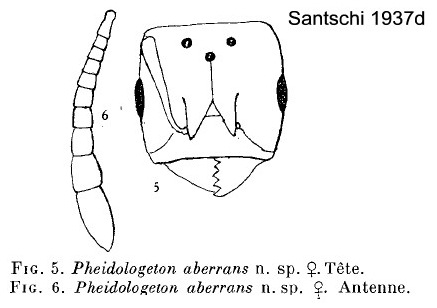 Queen TL 7.5-8 mm; pitch-brown; underside darker; sides
of head and appendages lighter Queen TL 7.5-8 mm; pitch-brown; underside darker; sides
of head and appendages lighterPhotomontage on species page |
Angola - aberrans |
| All forms described but from Africa there is only a single dubious record from Guinea | 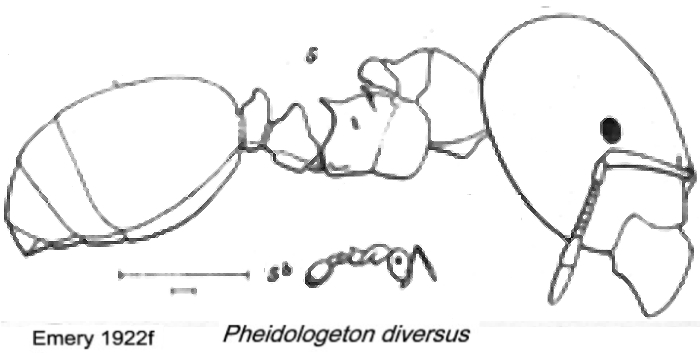 Minors
TL ca 2.5 mm. Majors TL to 13 mm. Colour yellowish brown to
reddish brown in minors: reddish brown to blackish brown in majors. Minors
TL ca 2.5 mm. Majors TL to 13 mm. Colour yellowish brown to
reddish brown in minors: reddish brown to blackish brown in majors. Minors with head rectangular with weakly convex posterior margin in frontal view; mandibles each with 5 teeth; antennal scapes short, not exceeding posterior margin of head; each of the apical two funicular segments long, their combined length longer than the rest of funiculus; promesonotum relatively strongly convex in profile; metanotal groove deeply incised; dorsum of propodeum convex; propodeal spines long, with acute apices. Majors with head proportionately large, almost square, with convex posterior margin in frontal view; anterior margin of clypeus straight, with a shallow median notch; mandibles large, triangular, with an acute apical tooth; masticatory margins without distinct teeth; eyes relatively small; ocelli present; antennal scapes 0.5 times as long as head; subpetiolar process present Queen TL 19-20 mm; morphology like the major but darker Male TL 13 mm |
. |
| . | 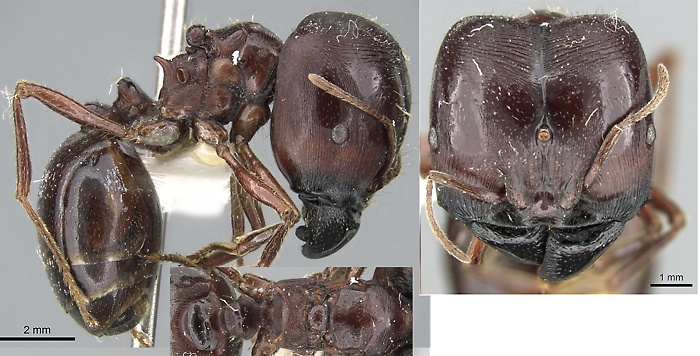 Major Major
|
South Asia - African record dubious - diversus |
| Major & minor | 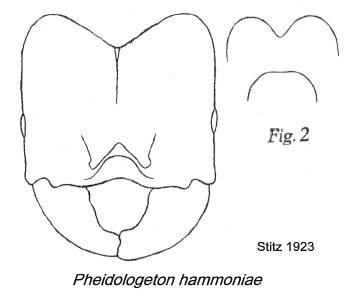 Major
TL ca 10 mm + 4 mm head; minor TL 7 mm + 3 mm, down to TL 2 mm (?);
major with head and alitrunk brown, occipitus darker; appendages yellow
brown; pedicel and gaster dark brown, also mandibles; smaller workers
more uniform brown Major
TL ca 10 mm + 4 mm head; minor TL 7 mm + 3 mm, down to TL 2 mm (?);
major with head and alitrunk brown, occipitus darker; appendages yellow
brown; pedicel and gaster dark brown, also mandibles; smaller workers
more uniform brown |
Namibia - hammoniae |
| Minor & queen only described | TL ca 3.2 mm; ferruginous,
gaster dark, sometimes black; alitrunk legs and antennae lighter than
head Queen TL only ca 6.8 mm |
South Africa - hostilis |
| Minor, major & queen | 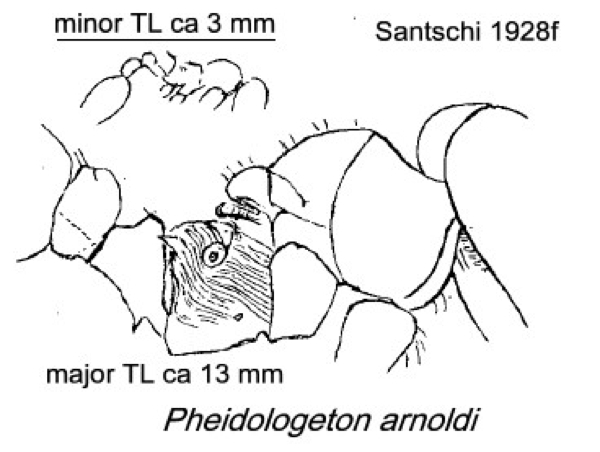 Major
TL ca 13 mm; ferruginous-red; clypeus, mandibles
and gaster dark brown; antennae and legs paler; anterior of head
striated Major
TL ca 13 mm; ferruginous-red; clypeus, mandibles
and gaster dark brown; antennae and legs paler; anterior of head
striated |
Namibia - kunensis |
| Major only
described |
Major TL 11 mm; ferruginous-red;
antennae paler; head, petiole and gaster darker |
South Africa - mayri |
| MYRMICINAE Introduction |
© 2007, 2010, 2013, 2014, 2018 - Brian Taylor CBiol FRSB FRES 11, Grazingfield, Wilford, Nottingham, NG11 7FN, U.K. |
href="pheidologeton.htm"